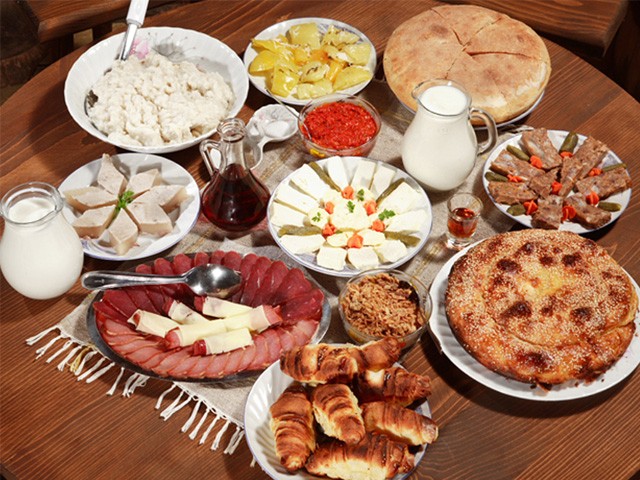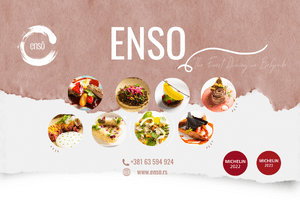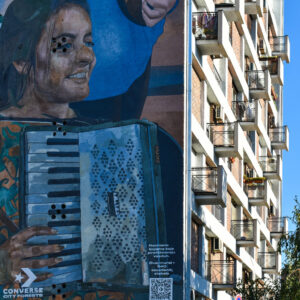
Serbian cuisine is a heterogeneous cuisine, sharing characteristics of the Balkans ( specially former Yugoslavia), the Mediterranean (Greek and Turkish, and Central European (Austrian and Hungarian) cuisines.
Serbian food is characterized not only of elements from Serbia, but of elements from the former-Yugoslavia. During the centuries under Ottoman rule, the Balkans were influenced by the rich oriental cuisine and some of the most traditional Serbian dishes have common roots with those of Greece and Turkey. Centuries of Austrian and Austro-Hungarian rule richly influenced Serbian cuisine, especially Serbian desserts.
Breakfast
Breakfast in Serbia is an early but hearty meal, although before breakfast most people usually take a cup of Turkish coffee, or maybe an espresso. With the breakfast itself either a tea, milk, milk coffee, or cocoa milk is served, pastries or bread are served with butter, jam, yogurt, sour cream and cheese, accompanied by bacon, sausages, salami, scrambled eggs and kajmak.
- Various sorts of pastries (often with cheese or meat or filled with jam)
- Burek
- Kačamak
- Popara
- Proja (cornbread)
- Čalabrca
- Eggs
- Kajgana (scrambled eggs)
- Jaje na oko (fried eggs)
- Rovito jaje (soft-boiled egg)
- Kuvano jaje (hard-boiled egg)
Soups
There are two types of soups in Serbian cuisine: standard soups called supa, and soups with roux (browned flour) – called čorba. Fisherman’s soup (riblja čorba) and lamb soup (jagnjeca čorba) are also very represented.
- Goveđa supa (Consommé)
- Teleća čorba (Veal ragout soup)
- Jagnjeća čorba (Lamb ragout soup)
- Fisherman’s soup
- Čorba od ječma i sočiva (Barley and lentil soup)
- Paradajz čorba (Tomato soup)
- Čorba od luka (Onion soup)
- Ljuta krompir čorba (Spicy potato soup)
- Čorba jajaruša (Egg soup)
Main course
The main course is always a meat dish.
- Pečenje (Roasted meat -whole roasted pork, lamb and goat)
- Gulaš, (Goulash)
- Đuveč (stewed vegetables and pork similar to Ratatouille)
- Karađorđeva šnicla (breaded rolled steak stuffed with kajmak and occasionally ham slices and cream cheese)
- Kavurma (lamb or pig intestines)
- Wiener schnitzel (Bečka šnicla)
- Moussaka (Musaka, made with aubergines/eggplant, potatoes or zucchini)
- Mućkalica (diced pork with a pepper and tomato hot sauce)
- Paprikaš (pork and pepper stew)
- Podvarak (stewed sauerkraut, usually with meat and bacon pieces)
- Prebranac (baked beans in sauce)
- Sataraš (stewed vegetables, similar to Ratatouille)
- Sarma (sauerkraut rolls)
- Tripes (škembići)
- Noodles with poppy (Rezanci s makom)
- Pihtije
- Pasulj (a thin bean stew)
- Punjene paprike (peppers stuffed with ground meat, onion, and rice)
- Punjene tikvice (stuffed zucchini)
- Wedding cabbage, (Svadbarski kupus) (cooked sauerkraut with smoked pork)
- Dumplings (valjušci or flekice) with potatoes or cabbage
- Meat and vegetables cooked under backing lid
Roštilj (Barbecue)
Grilled meats are the primary main course dishes offered in most restaurants. They are often eaten as fast food.
- Pljeskavica (hamburger) National Dish
- Ćevapčići (ground meat sticks) National Dish
- Vešalica (grilled strips of pork loin)
- Various sausages
- Mixed grill (mešano meso)
- Skewered kabobs (ražnjići)
- Leskovački roštilj (Leskovac grills)
Salads
The simplest of salads are made of sliced lettuce, cabbage, sauerkraut, tomato, cucumber or carrot without any preparation or dressing at all. Oil, vinegar and salt could be added as a dressing, occasionally spiced with pepper or paprika. Beetroot or potato salads require cooking and oil, vinegar and salt.
More complex salads are prepared in a similar way, but by mixing several kinds of vegetables, together with white cheese, garlic and other spices. These include:
- Serbian salad (Srpska salata)
- Shop salad (Šopska salata)
- Greek salad (Grčka salata)
- Kisele paprike (roasted green papers with garlic and vinegar)
Finally, there are salads with complex preparation that could even be eaten as a part of the main course:
- Russian salad (Ruska salata)
- Mimoza
Relishes
- Ajvar
- Ljutenica
- Urnebes
- Pinđur
Rakija
Of distilled beverages, the most popular are various fruit brandies called rakija. Comparatively many people brew their own rakija, which is highly prized by friends and relatives. Rakija is famous for being smooth but very alcoholic and it is said that one can’t get a hangover from it. Serbian rakija is a prized commodity and is very difficult to find elsewhere in the world. Various kinds of rakija are named after fruit they are made of.
Among the most known ones are:
- Šljivovica (Plum brandy)
- Lozovača (Grape brandy)
- Viljamovka (Pear brandy)
- Klekovača
- Jabukovača (Apple brendy)
- Stomaklija
- Pelinkovac (a wormwood liqueur milder than Absinthe)

Writer. Blogger. Traveler. Researcher. Electronic Music Lover.

















Hello Still in Belgrade,
thank you very much for all the lovely articles you publish.
Just a little addition to this post about Serbian cuisine – Klekovaca is normally a sort of plum brandy infused with juniper berries.
Kind regards,
Neda